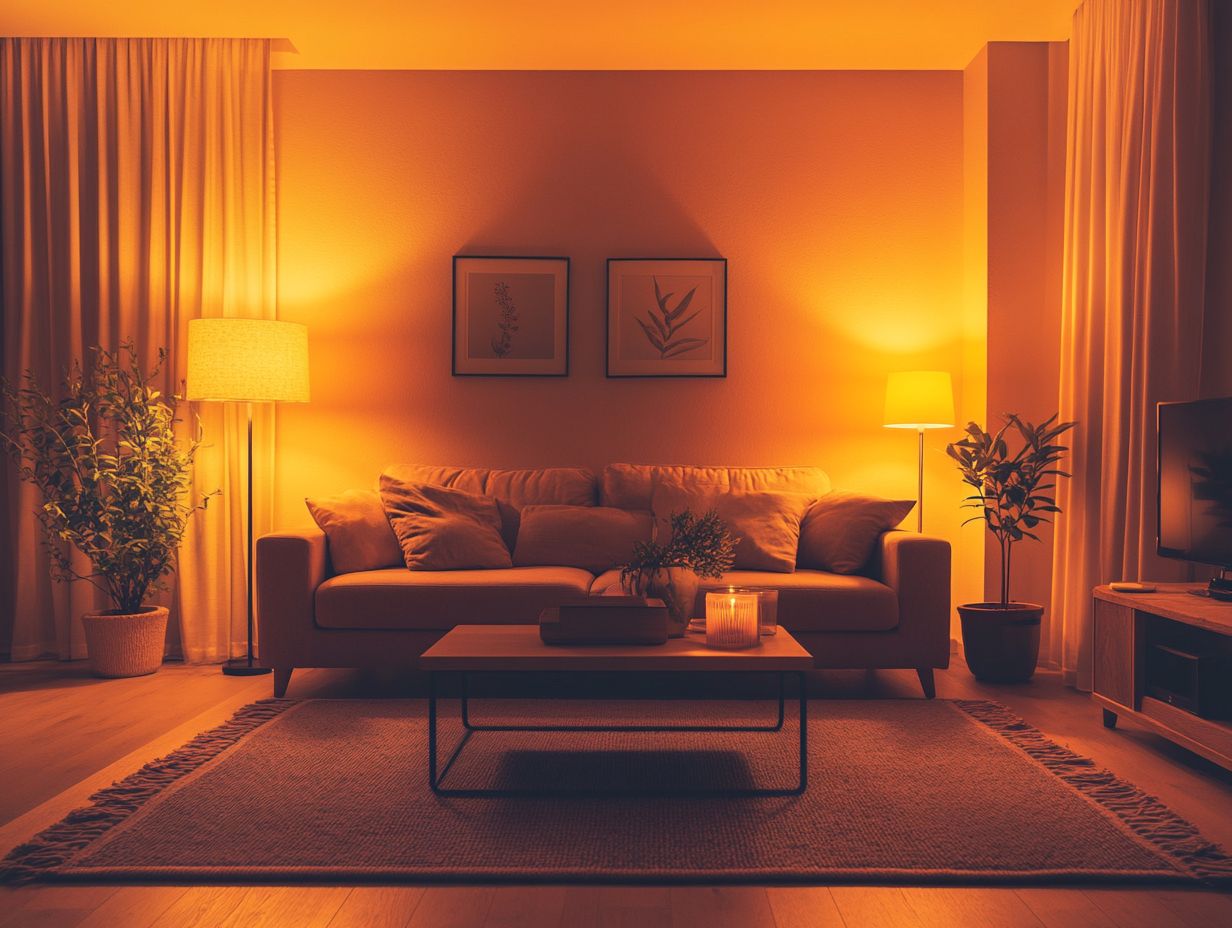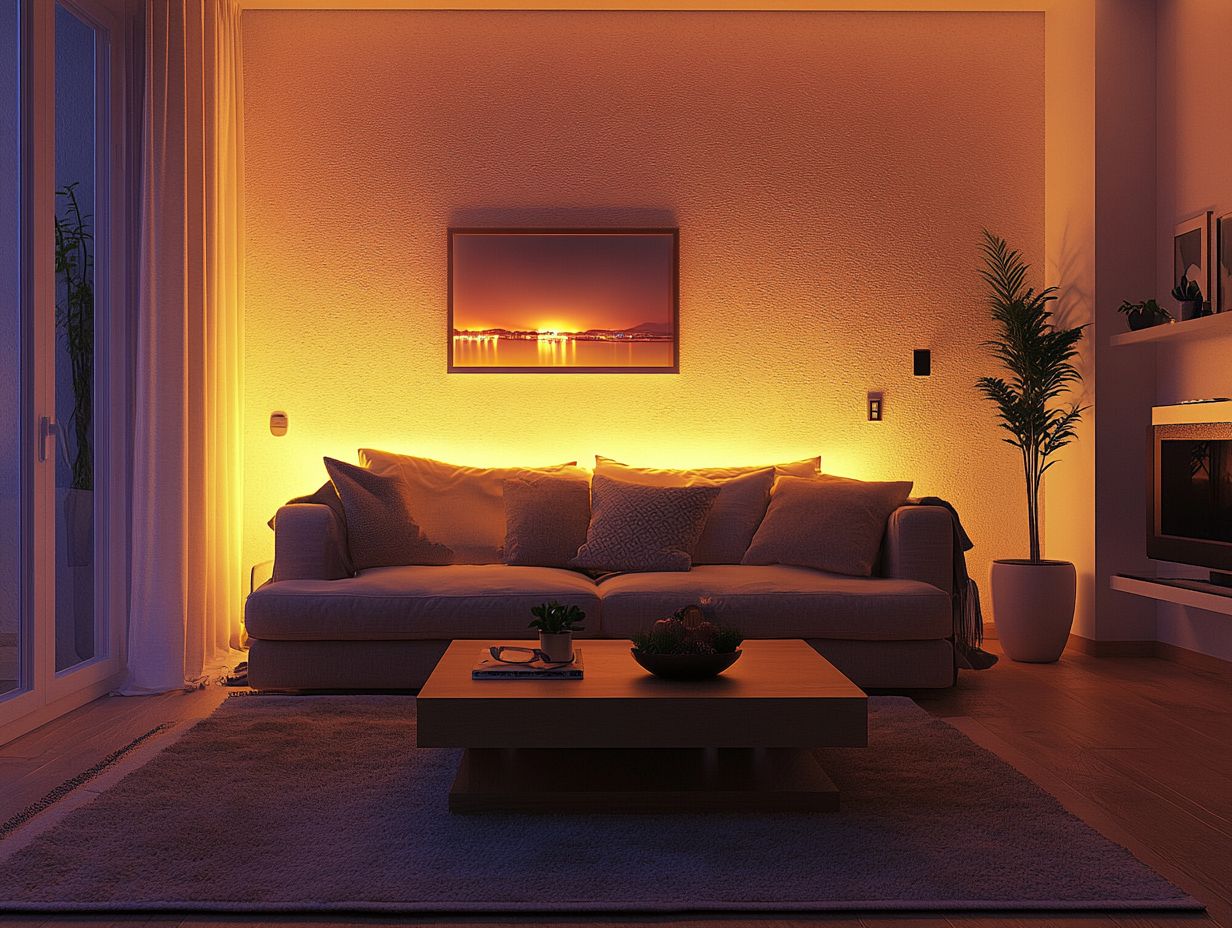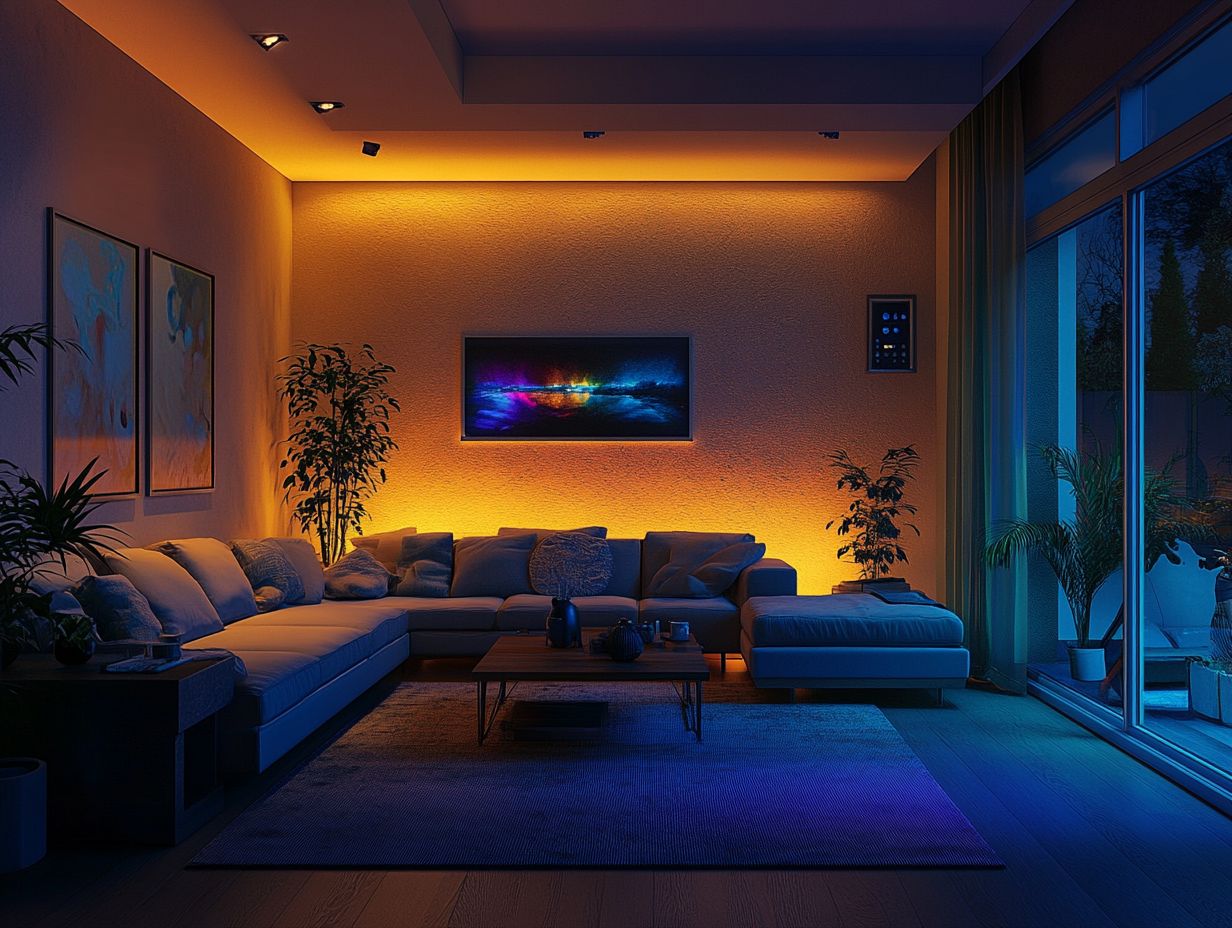Creating the optimal ambiance within one’s home often relies on the appropriate lighting solutions.
Dimmer controls present a versatile option that enables individuals to adjust brightness levels for various occasions, thereby enhancing mood and atmosphere while also promoting energy efficiency.
Whether one is contemplating traditional or smart dimmers, comprehending their advantages and types can significantly transform living spaces.
This guide addresses the essentials of dimmer controls, encompassing installation tips and troubleshooting common issues, ultimately helping withdividuals in achieving the desired lighting for any situation.
Understanding Dimmer Controls

A comprehensive understanding of dimmer controls is essential for individuals seeking to enhance their living environments. Dimmer controls enable users to adjust lighting levels, thereby creating the ideal ambiance for various occasions.
By utilizing adjustable brightness, one can effectively transform a room’s atmosphere from bright task lighting to soft mood lighting, accommodating diverse user preferences. These controls also play a significant role in improving energy efficiency by reducing electricity consumption, thereby serving as a valuable addition to modern home automation systems.
Furthermore, they enhance the aesthetic appeal of light fixtures, integrating seamlessly with contemporary interior design trends.
What are Dimmer Controls?
Dimmer controls are specialized devices designed to adjust the brightness of light fixtures, providing users with enhanced control over their lighting environments. Available in various forms, these devices accommodate diverse preferences and technological advancements, making them suitable for both residential and commercial applications. Whether one chooses traditional dimming switches or advanced smart dimmers, a comprehensive understanding of their functionalities can significantly improve the overall lighting experience and energy efficiency.
Traditional dimmers generally operate using resistance to reduce light output, while modern smart dimmers employ advanced technology to facilitate app-based control. This allows users to customize brightness levels remotely or through voice commands.
Smart dimmers often integrate seamlessly with home automation systems, demonstrating compatibility with a wide range of light fixtures, including incandescent, LED, and CFL bulbs. This versatility allows for the transformation of any room’s ambiance while optimizing energy consumption. Conversely, traditional dimming switches are straightforward in operation but may face compatibility limitations with certain LED lights, potentially resulting in flickering if not paired correctly.
By understanding the various types of controls and their mechanisms, users can make informed decisions, tailoring their lighting solutions to meet specific needs and preferences.
Benefits of Using Dimmer Controls
The advantages of utilizing dimmer controls extend well beyond simple brightness modification; they are integral to mood enhancement and energy efficiency in both residential and commercial environments.
By facilitating customizable lighting scenarios, dimmers give the power to users to create a range of lighting effects that can significantly alter the atmosphere of any room. These controls offer the flexibility to transition between bright task lighting conducive to work and softer ambient lighting suitable for relaxation, thereby enriching the overall experience within the space.
Moreover, dimmer controls can contribute to substantial energy savings by decreasing power consumption as light intensity is reduced.
Enhancing Mood and Atmosphere
Enhancing mood and atmosphere is a significant advantage of employing dimmer controls in lighting design, enabling users to customize their environment to accommodate various occasions and emotional requirements.
By adjusting light intensity, individuals can establish an ambiance that aligns with their current mood or intended activity, whether it involves a cozy dinner with friends or a focused work session. This flexibility in lighting is vital in interior design, as it not only determines the emotional tone of a space but also affects the perception of colors and textures.
Warm hues can evoke feelings of comfort and relaxation, while brighter lights may promote energy or creativity. Therefore, recognizing the impact of mood lighting is essential for anyone aiming to enhance their living spaces, ensuring that each room fulfills its intended purpose and engages occupants on a deeper emotional level.
Energy Efficiency

Energy efficiency represents a significant advantage of dimmer controls, especially when utilized with LED lighting, which is renowned for its energy-saving attributes.
By adjusting the brightness levels of LEDs, users can create the desired ambiance while also markedly reducing overall energy consumption. This strategic approach ensures that less electricity is utilized when full brightness is not required, rendering it a cost-effective option for both residential and commercial environments.
The compatibility between dimmers and energy-efficient bulbs has notably improved, facilitating optimal performance while preserving high energy ratings. Consequently, this combination can lead to considerable savings on electricity bills, exemplifying how a simple adjustment can enhance the sustainability and efficiency of lighting solutions.
Types of Dimmer Controls
When examining the various types of dimmer controls available in the market, it is essential to distinguish between traditional dimmers and modern smart dimmers, as each serves distinct user preferences and technological integrations.
Traditional dimmers provide straightforward functionality, permitting manual brightness adjustments through physical switches. In contrast, smart dimmers are equipped with advanced features such as wireless controls and Bluetooth connectivity, allowing users to manage lighting remotely through smart home devices and applications.
This evolution in dimming technology underscores the increasing trend toward integrated home automation systems.
Traditional vs. Smart Dimmers
Traditional dimmers primarily provide fundamental control over lighting, enabling users to manually adjust brightness levels. In contrast, smart dimmers incorporate advanced technology, offering enhanced functionality and an improved user experience.
The user interface of traditional dimmers typically consists of basic toggle switches or rotary knobs, rendering them straightforward yet limited in terms of versatility. Conversely, smart dimmers often feature touchscreens or mobile app controls, delivering an intuitive experience that caters to tech-savvy users.
The ease of installation varies considerably between the two; traditional dimmers generally require minimal effort, as they involve simply replacing an old switch, whereas smart dimmers may necessitate more complex wiring and setup procedures. Recent advancements in dimming technology further facilitate smoother transitions and improve energy efficiency, highlighting how these differences can significantly enhance lighting control systems in modern homes.
Factors to Consider Before Installing Dimmer Controls
Before installing dimmer controls, it is essential to consider several critical factors to ensure optimal functionality and safety within your lighting setup.
Compatibility with existing light fixtures and wiring systems is of utmost importance, as not all dimmers are suitable for every type of bulb, particularly with regard to LED compatibility. Additionally, adherence to electrical safety standards is crucial to prevent potential hazards, necessitating a thorough understanding of circuit compatibility and load ratings.
Dedicating time to assess these factors will facilitate a seamless installation process and contribute to a safe lighting environment.
Compatibility with Existing Lighting Fixtures

Compatibility with existing lighting fixtures is a critical consideration when selecting dimmer controls, as not all light fixtures are designed to support dimming functionality.
A comprehensive understanding of the various lighting options, including incandescent, LED, and fluorescent bulbs, can significantly enhance both the ambiance and efficiency of any space.
The installation of dimmers facilitates improved control over brightness levels, which can positively influence mood and reduce energy consumption.
Retrofitting older fixtures for compatibility with modern dimmers is increasingly practical; a variety of adapters and replacement bulbs are available, enabling homeowners to capitalize on the advantages of dimming without necessitating a complete redesign.
The optimal selection of dimmable options not only enhances visual comfort but also extends the lifespan of bulbs while promoting energy savings.
Wiring and Electrical Considerations
Wiring and electrical considerations are critical in the installation process of dimmer controls, as improper connections can result in safety hazards and system malfunctions.
To ensure a successful installation, it is essential for users to familiarize themselves with safe wiring practices and adhere strictly to electrical safety standards. This includes deactivating the power at the circuit breaker to prevent accidental electric shocks and utilizing insulated tools to avoid contact with live wires.
Furthermore, individuals should verify that the existing circuit is compatible with the new dimmer switch to prevent overloads or flickering lights, which may occur if the wattage limits are exceeded. Consulting the device manual can provide valuable installation guidance and confirm compatibility, thereby contributing to a reliable and safe electrical environment.
Installation and Usage Tips
The proper installation and utilization of dimmer controls are crucial for maximizing their benefits and ensuring a user-friendly experience in various lighting environments, whether for decorative purposes or task-oriented spaces. Incorporating smart lighting options can further enhance versatility.
Adhering to appropriate installation guidelines can significantly enhance functionality and usability. By selecting the correct dimming technology and applying best practices during installation, users can effectively create a seamless ambiance that is tailored to their specific preferences.
Proper Installation Techniques
Proper installation techniques are essential for ensuring that dimmer controls function effectively and safely within a lighting system. This involves understanding lighting design principles that govern optimal setups.
These methods not only enhance the overall performance of the controls but also significantly contribute to maintaining an efficient and secure electrical environment. Adhering to electrical safety standards, such as utilizing the appropriate gauge wire and correctly rated circuit breakers, is fundamental in preventing potential hazards.
Furthermore, a thorough understanding of user interface designs and control protocols can greatly enhance both the ease of use and functionality of dimmer controls. Therefore, integrating these best practices serves as a comprehensive guide that ensures the safe operation and longevity of the entire lighting setup.
Optimizing Dimmer Controls for Different Spaces

Optimizing dimmer controls for various environments, whether residential or commercial, necessitates a comprehensive understanding of how lighting affects the overall atmosphere and functionality of a space. This includes considerations of color temperature to achieve the desired effects.
In a home theater, for example, adjusting the dimmer settings to create a darker environment enhances the cinematic experience by reducing glare on screens and immersing viewers more fully in the film. Conversely, in task-oriented areas such as kitchens or offices, adjustable brightness is essential for supporting specific activities like cooking or reading, ensuring that the lighting is neither excessively harsh nor insufficiently dim.
These adjustments are critical, as the appropriate lighting ambiance not only fosters comfort but also enhances productivity and mood, facilitating customized experiences that cater to a variety of daily requirements.
Troubleshooting Common Issues
Troubleshooting common issues with dimmer controls is essential for maintaining an optimal lighting experience and ensuring proper functionality over time. Problems such as flickering lights or unwanted noise can significantly affect the effectiveness of a lighting setup, diminishing the ambiance and mood-setting capabilities that dimmers are intended to enhance. Recognizing the importance of energy efficiency can also lead to smarter choices.
A thorough understanding of how to diagnose and resolve these issues can contribute to a more satisfactory user experience.
Fixing Flickering Lights
Addressing flickering lights is a common issue encountered by many users when utilizing dimmer controls, typically indicative of compatibility challenges or suboptimal installation practices. Utilizing LED lights can help in addressing some of these challenges.
This frustrating occurrence, often experienced during routine use, can arise from various factors, including mismatched wattage between the bulb and the fixture, as well as the specific type of dimmer switch employed. Older dimmer models, in particular, may not be compatible with modern LED lights or CFL bulbs, resulting in unstable lighting.
To rectify this issue, it is advisable to ensure that the bulbs are compatible with the dimmer. Additionally, upgrading to a more advanced dimmer specifically designed to accommodate various bulb types may also be a beneficial solution.
Ultimately, identifying the root cause of the flickering not only enhances lighting quality but also ensures safety within the home.
Addressing Noise or Buzzing Sounds
Addressing noise or buzzing sounds emanating from dimmer controls is crucial for maintaining a peaceful and comfortable lighting environment. Utilizing smart dimmer switches may also help reduce noise levels.
Such disturbances may arise from various sources, including electrical issues, incompatible bulbs, or the configuration of the dimmer itself. It is essential to ensure that the installed dimmer switch corresponds appropriately with the types of bulbs being utilized—whether incandescent, LED, or CFL—since mismatched combinations can exacerbate unwanted sounds.
To troubleshoot the issue, begin by inspecting for loose connections or damaged wires within the switch. Subsequently, replace any incompatible bulbs or consider upgrading to a dimmer specifically designed for LED lighting. Often, a simple adjustment of the settings or a reset of the dimmer can effectively resolve these bothersome sounds, thereby restoring tranquility to the space.